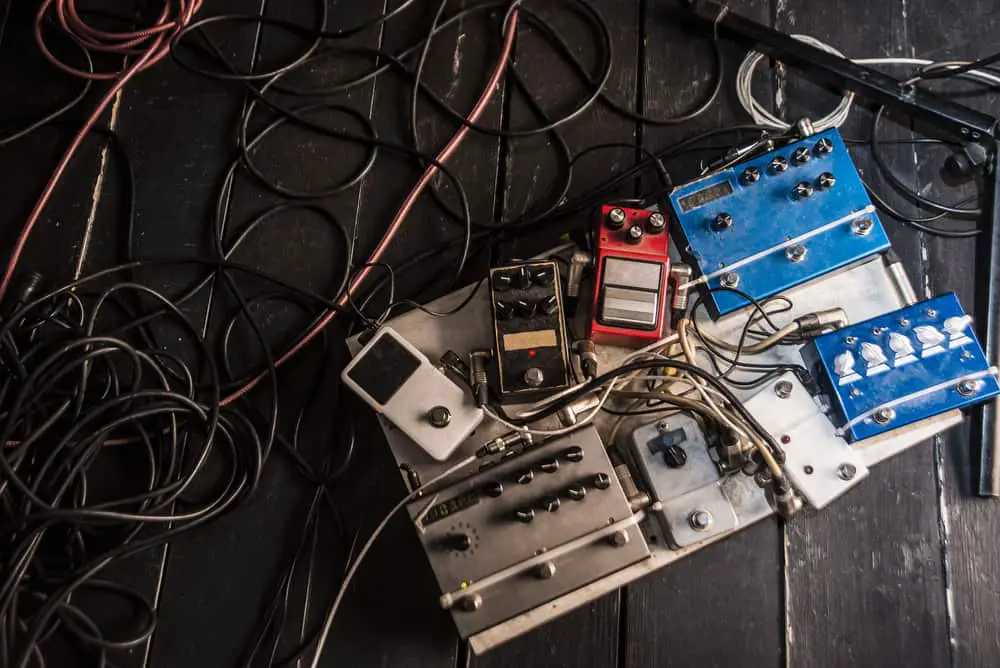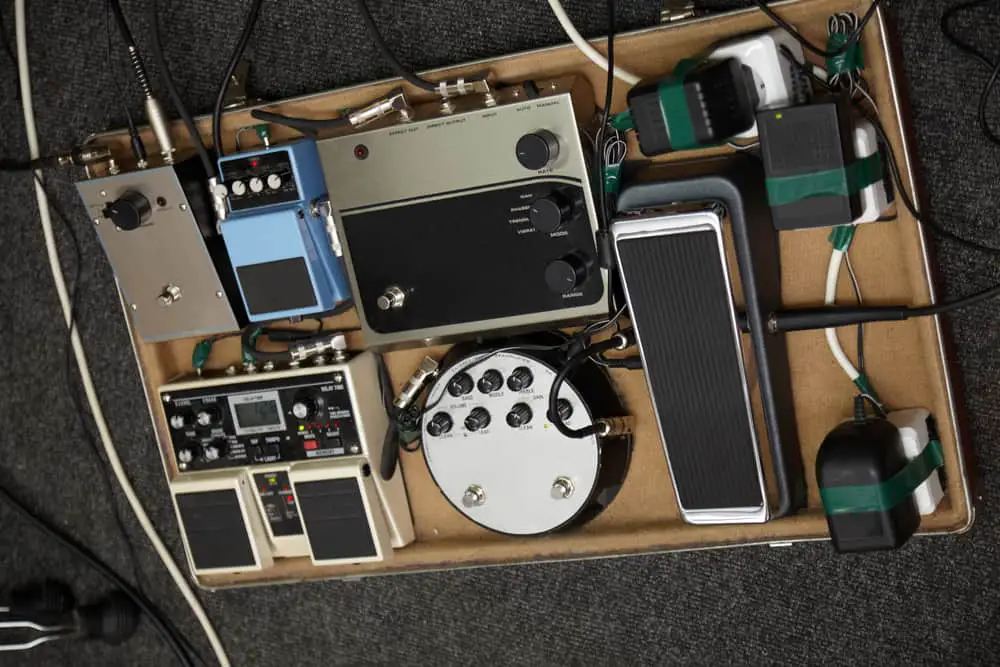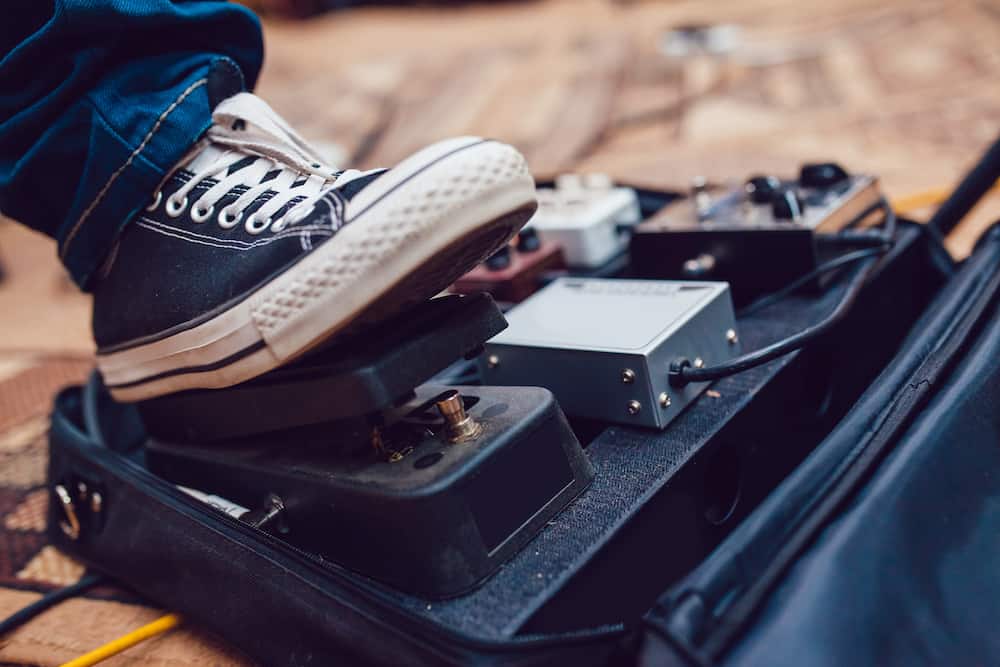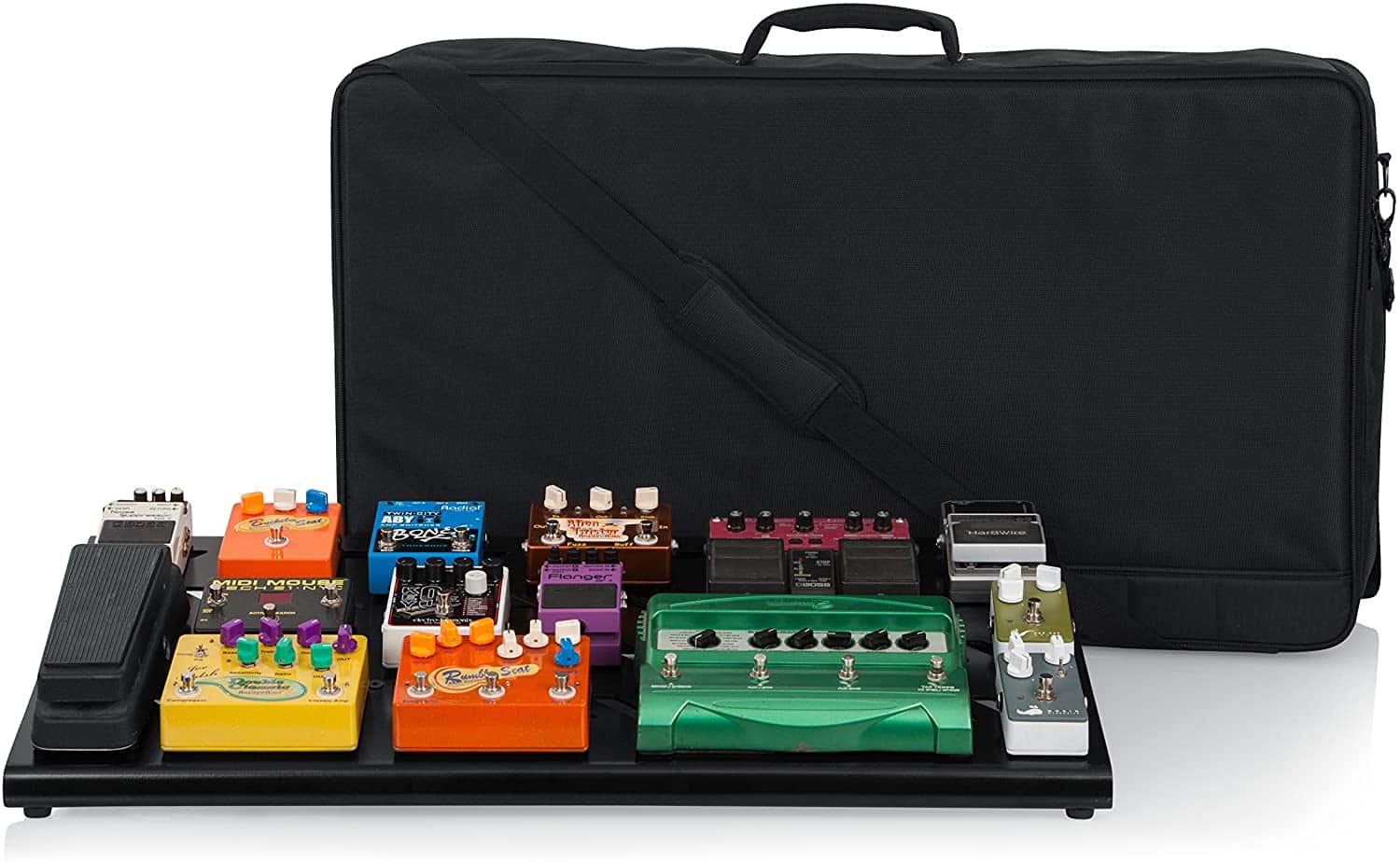When guitarists are looking to customize their sound, the best way to do that is with effects pedals.
In fact, if you have been playing for a while, we are sure you have quite a few pedals lying around.
This may bring about the conundrum of how to hook them up so that you get the most from them.

It can feel a bit overwhelming and confusing when you first try to arrange your guitar pedals, especially if you have never had to do it before.
That said, there is actually a method to that madness which will make it very easy for you to learn how to arrange guitar pedals in no time.
Creative endeavors never have one way of being done, but there are things that you do that can cause problems.
For instance, maybe you have everything set up and your turn the pedal chain on, and all you get is static or even silence.
This means that something is not set up correctly, so to keep you from experiencing this, we thought we would take a good look at how to set up guitar effects pedals.
Also read: how to power all of the pedals on your pedalboard
Rules to pedalboards
Like with everything else, there are always tips and tricks you should know about before you start to work on your project.
Though not chiseled in stone, these tips, tricks, or rules — whatever you want to call them — will help you start off on the right foot.
Before we get to the order of which you should set up your signal chain to get the most from them, let’s take a look at some of the best tips to keep in mind as you build out your custom chain.
How to Arrange Guitar Pedals
The best way to get started is to think about your pedals as if they were blocks that needed to be arranged.
As you add a block (pedal), you are adding a new dimension to the tone. You are essentially building your tone’s overall structure.
Remember that every block (pedal), influences all those that come after it so the order can be quite impactful.
Also read: comparison guide to getting the best pedals for your sound
Experiment
There really are no set rules about anything. Just because there is an order that everyone says works the best doesn’t mean that your sound isn’t hidden in a place no one has thought to look.
There are just some pedals that work better in certain parts of the chain. For instance, octave pedals tend to do better before distortion.
Some pedals naturally give off noise. High gain distortion is one of those, and so pedals that add volume can increase this noise.
That means that to get the most out of these pedals, you will want to put them after volume pedals like EQ or compressors.
The trick to creating a pedal chain that works the most efficiently is to think about how the sound is created in space.
That would mean that things like reverb and delay that are produced in three dimensions should come last in the chain.
Once again, though these are excellent guides, they are not set in stone. Play around and see if you can create a sound that is all your own.
By using the structure and then tweaking it a bit, you will be able to create some unique sound creation.

What order do pedals go on a pedalboard?
If you are not looking to craft your own sound, but rather want to build an iconic sound within a field that has already been created, you should stick with the traditional pedal chain layout.
There are tried-and-true pedal chain setups for every sound, and the most basic one is:
- Boost/ level or “filters”
- EQ/wah
- Gain/ Drive
- Modulation
- Time-related
If you are looking to use your role model’s sound, you can always search for their name and pedal setup and see what happens.
But with that being said, there is a patent order that you should understand.
There is a pre-determined order of pedals which seems to be universally accepted for the most part:
- Filters: These pedals literally filter altering frequencies, so they tend to go first in your chain. You would find compressors, EQs, and wah pedals to be considered filters that would be placed first.
- Gain/ Drive: You want to make sure that overdrive and distortion make an early appearance in your chain. You can put them either before or after your filters. That particular sequence would depend on your personal preference as well as your overall style.
- Modulation: The middle of your chain should be dominated by flangers, chorus, and phasers.
- Time-based: This is the spot directly in front of your amp. It should include reverbs and save delays.
While this order is understood, it is not a hard and fast set of rules.
There are reasons this order is laid out this way but ultimately, the choice is yours when it comes to arranging guitar pedals.
The Details

Let’s discuss each one of them in detail.
Boost/ compression/ volume
The first thing you’ll want to tackle is getting the pure guitar sound up to the level that you want.
This includes the use of compression for leveling out your pick attack or hammer-ons, a booster pedal to boost your signal, and straight-up volume pedals.
Also read: this is the best booster pedal on the market right now by Xotic
Filters
Included in your filters are compressions, EQs and Wahs. A lot of guitarists will put their wah pedal at the very beginning, in front of anything else.
The reason for that is the sound is understood to be purer and a little more subdued.
Those guitarists who like a smooth overdrive instead of distortion are usually the ones who prefer this sequence over other potential ones.
The alternative is to put the distortion ahead of the wah. With this approach, the wah effect is greater, more aggressive, and bolder.
This is usually the preferred sound for rock players.
The same approach can be taken with EQ pedals and compressors.
A compressor tends to work best when it follows the distortion or when it is between the distortion and the wah but some guitarists still prefer it at the very end to compress everything.
If you put an EQ first in the chain, you can reshape the guitar’s pickup sounds before any other effects.
If you put it before distortion, you can choose which frequencies the distortion will emphasize.
Finally, putting the EQ after distortion is a good choice if the distortion will create a harshness once select frequencies are reached.
If you want to dial that harshness back, putting the EQ after distortion is a favorable choice.
EQ/Wah
Next up in the chain, you want to place your EQ or wah wah.
This type of pedal gets the most for its skill when directly working with a distorted sound like those produced by drive pedals.
If the compressor is one of the pedals, you can choose to play with its location, dependent on the style of music.
For rock, place the compressor at the beginning of the chain after the distortion. If you work in country music, try at the end of the pedal chain.
Gain/ Drive
In this category comes pedals like overdrive, distortion, or fuzz. These pedals are typically placed relatively at the beginning of the chain.
This is done because you want to affect the tone from your guitar at the purest point with this pedal.
Otherwise, you will be distortion the sound of your guitar mixed with whatever pedal is before it.
If you have multiple of these, you may want to add a boost pedal before the other, so you are getting a strong signal.
A distortion pedal might be the first one you purchase, and you might find that you accumulate them faster than any others.
If you put distortion early in your chain, you are going to accomplish a couple of different things.
To start, you will push a harder signal which is your ultimate goal since you want to do that as opposed to the signal from a phaser or chorus.
The second accomplishment is that modulation pedals often have a thicker sound when overdrive is in front of them as opposed to behind.
If you find that you have two gain pedals, you can really just put both on to get the maximum amount of distortion pushed through your amp.
In that sense, there really is no difference between which goes first in the chain.
That said, if the two pedals you have offer extremely different sounds, you will have to decide for yourself which you want to put first.
Modulation
In this category of pedal, you will find phasers, flanger, chorus, or vibrato effects. After the wah, these pedals gain a more vibrant tone with more complex sounds.
Making sure that these pedals find just the right location in your pedal is crucial as if laced in the wrong place, you may find their effects to be limited.
That’s why most guitarists place these in the middle of the chain.
Modulation effects are almost always in the middle of the chain and for a good reason.
Not every modulation effect is created equal and each can offer very different sounds.
While some are gentler, others are bolder so you need to keep in mind that pedals will impact whatever comes after them.
That means you want to be particularly conscious of the bolder sounds you might be producing and think about how that will impact the rest of the pedals in the chain.
If you are using several different modulation pedals, a good rule of thumb is to arrange in ascending order of aggressiveness.
If that is the approach you take, you will likely find that you start with the chorus and then move to a flanger and finally phaser.
Time-Related
Delay and reverb live in this wheelhouse, and they are best at the end of the chain. This gives all the effects of a natural echo.
Other effects will not change this. This effect is best at the end of the chain if you want a loose reverb that helps make the sound fill a room like an auditorium.
Time-based effects are usually placed last in any chain. That is because both delay and reverb repeat the signal of your guitar.
By placing them last, you will find that you get increased clarity, impacting the sound of every single pedal that was earlier in your chain.
It serves as a bit of a booster if you want to think of it that way.
You can experiment if you want but you should know the effect of putting time-based effects earlier in your chain.
Ultimately, it will give you a split signal.
That signal will travel through every single pedal which comes after it which will then leave you with a mushy, inarticulate sound that really will not be very pleasant.
This is why it makes sense to keep your signal tight and reserve the delay and reverb for the very end of the effects chain.
Also read: make your own effect chains with these best multi effect units under $100
How to build a pedalboard
Making your own pedalboard is relatively easy once you know the right order.
Unless you want to completely build your board from scratch using a wooden board and some velcro, your best bet is to buy a good ready-made one with a sturdy bag so you can get it from practice room to gig.
My favorite brand is this one from Gator for their heavy-duty boards and gigbags, and they come in a lot of different sizes:

Final Thoughts
Experimenting is the key. The order described here is really meant as a starting point if you are new to playing guitar or if you want to switch things up or get some new ideas.
There is nothing wrong with experimenting a bit and trying out different orders to see what sounds speak to you the most.
There isn’t actually a right or wrong answer as much of the order will be driven by your personal preference.
What matters most is you enjoy the sound you are making, as it is your sound and really no one else’s.
Ultimately, you determine how to arrange guitar pedals for yourself but this can be a useful guide in the more universal way of doing it.
There are so many different types of effects to play with on the market that can be used in combination to create a unique sound.
Having some simple ideas of the right order, it then gives you room to play. In other words, you have to know the rules before you can break them.
Understanding the mechanics of sound creation and how each effect will affect the other allows you to make the most of each of your pedals.
Whether you are dealing with two or six, this outline will get you the furthest.
Whether you are going rogue or sticking to the tried and true, understanding everything about the effects created and how they are created can help you use science to transform your sound effectively.
Also read: these are the best solid-state amps to use for metal
I'm Joost Nusselder, the founder of Neaera and a content marketer, dad, and love trying out new equipment with guitar at the heart of my passion, and together with my team, I've been creating in-depth blog articles since 2020 to help loyal readers with recording and guitar tips.


